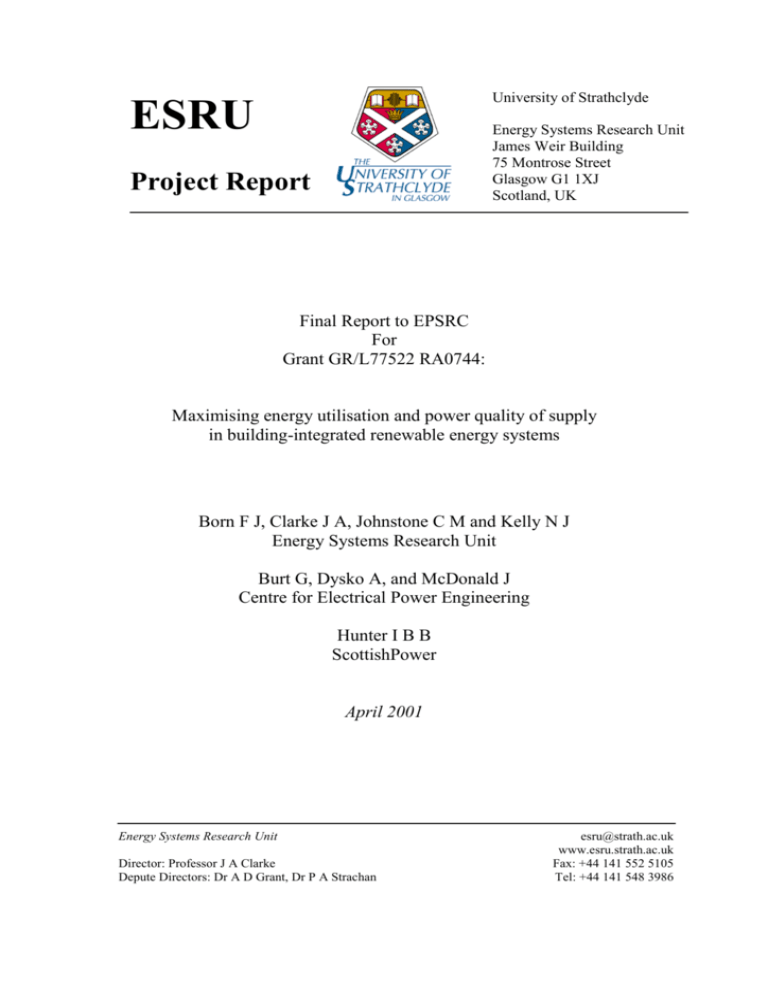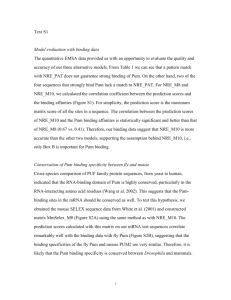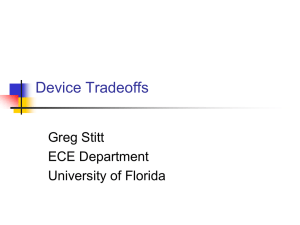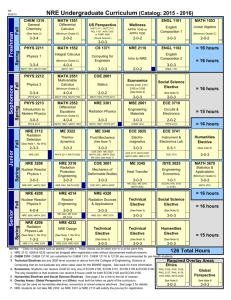Maximising energy utilisation and power quality of supply in building
advertisement

University of Strathclyde ESRU Energy Systems Research Unit James Weir Building 75 Montrose Street Glasgow G1 1XJ Scotland, UK Project Report Final Report to EPSRC For Grant GR/L77522 RA0744: Maximising energy utilisation and power quality of supply in building-integrated renewable energy systems Born F J, Clarke J A, Johnstone C M and Kelly N J Energy Systems Research Unit Burt G, Dysko A, and McDonald J Centre for Electrical Power Engineering Hunter I B B ScottishPower April 2001 Energy Systems Research Unit Director: Professor J A Clarke Depute Directors: Dr A D Grant, Dr P A Strachan esru@strath.ac.uk www.esru.strath.ac.uk Fax: +44 141 552 5105 Tel: +44 141 548 3986 MAXIMISING ENERGY UTILISATION AND POWER QUALITY OF SUPPLY IN BUILDING-INTEGRATED RENEWABLE ENERGY SYSTEMS Final Report: Grant GR/L77522 RA0744 1. Project context Network connection is often the preferred configuration for building-integrated new and renewable energy (NRE) systems. The generated electricity is exported to the local distribution network, while the building’s electricity demands are separately imported. The additional capital and operating costs that such isolated schemes place on network operators in terms of maintaining acceptable network performance are limited. The short-term acceptability of this approach is assured due to the small number of currently connected schemes and the existence of government subsidies. In the longer term, an increase in the number of intermittent, single phase supply systems using the public electricity supply (PES) network as a buffer device will introduce network imbalance and power quality problems [1]. The increasing costs associated with correcting these problems will not be absorbed by the network operators but passed on to the generators. In many cases, this additional cost will compromise the viability of small-scale NRE schemes and thus prove a hurdle to the attainment of national targets for NRE systems. Building-integrated NRE systems (e.g. photovoltaic components, small scale wind power, micro-gas turbines, fuel cells, solar thermal devices etc) have the potential to make a significant contribution towards the attainment of targets for reduced gaseous emissions [2]. For this to happen, new approaches to system configuration, component sizing and power utilisation are required in order to maximise the efficiency of energy use while not adversely affecting the quality of power available from the PES or local building network. Using the power from local NRE systems provides the potential that more of the grid’s export capacity remains available for future expansion. For NRE systems to attain significant levels of penetration, however, their impact in terms of depleting local power quality must also be addressed and mitigated. 2. Project plan review The project addressed two principal issues relating to the integration of NRE systems within the built environment: q how to maximise the utilisation of the generated power (heat and electricity) with respect to the design parameters affecting a building’s demand profile; and q how to maintain the quality of power supply in cases where co-operative switching occurs between locally deployed systems and the PES. These issues were addressed by an inter-disciplinary team comprising researchers from the University of Strathclyde’s Energy Systems Research Unit and Centre for Electrical Power Engineering, and personnel from ScottishPower’s Power Systems Division. Based on existing performance data, and information obtained from laboratory experiments, mathematical models of 11 NRE technologies were constructed and validated. A demand/supply matching procedure was then developed and, along with the supply models, encapsulated within a procedure termed bSmart [3] to enable q the identification of the potential for NRE systems deployment at any scale from a large region to a single building; q a technical appraisal of the options for integrating such systems within the built environment; q an assessment of the impact of these options on the local energy demand and environmental emissions; q the assessment of the impact on power quality—on the PES in the case of an NRE export link and on the building’s electrical network in the case of autonomous NRE utilisation; and q the development of a strategy for co-operative switching that enables the NRE-derived power to complement the PES without the need for an export connection. In order to verify the procedure and transfer its capability into practice, bSmart was applied within a major refurbishment project in the centre of Glasgow in association with Glasgow City Council, Page and Park Architects and Oscar Faber M&E Consultants. This involved the design and subsequent implementation of a scheme comprising several passive and active technologies within a portion of the city’s Lighthouse building (pic 1) designed by Charles Rennie Mackintosh [4]. The detailed design of each technology was undertaken and, for the case of novel PV-integrated ducted wind turbines (pic 2), 10 units were fabricated [5]. A subsequent monitoring exercise verified the approach and facilitated the establishment of a permanent Lighthouse exhibition on the theme of city-integrated RE systems [6]. Based on this successful case study, bSmart was applied within two further projects: a housing refurbishment in collaboration with Partick Housing Association, and a community redevelopment study in collaboration with Glasgow City Council. In the former case, a photovoltaic-integrated roof was designed and constructed [7]. This is the UK’s first implementation of a roof-integrated hybrid PV system capable of delivering both heat and power. In the latter case, several NRE embedded scenarios were investigated and a sub-set identified for further study [8]. At the time of writing, consideration is being given to the incorporation of these options within the community development plan. In order to allow the NRE systems and PES network to act co-operatively, and avoid the need for an export connection, a prototype smart inverter was designed, constructed and tested. The capabilities of this controller are described in §3.4. A model of the controller’s operational logic was then installed within bSmart. Several mechanisms were employed to disseminate the project’s outcomes (the bSmart system, the NRE supply models, the NRE component designs, the case study outcomes and the smart inverter): q components of the bSmart procedure were implemented within an architectural practice, an engineering consultancy, ScottishPower, MANWEB, Glasgow City Council and Highland Council and their trial application supported; q workshops were organised for engineering and energy services staff of ScottishPower and MANWEB, and for the member companies of the Scottish Energy Systems Group; q an international workshop was organised to coincide with the 16th European PV conference held in Glasgow in May 2000; q several conference and journal papers were published (see §9); q a major Web site (see §3.5) was established which gives access to the project’s aims, procedures and tangible outcomes and is suitable for both technical and non-technical visitors; q a portable exhibition ‘pod’ was constructed to support the promotion of local clean energy generation to the community at large, and especially to school pupils and college/university students; q and contributions were made to the Electricity Council’s G77 and G78 guidelines. Finally, an associated PhD programme was successfully completed within the 3 year period of the project [9] and one of the project Research Fellows has been invited onto the CIGRE Working Group for dynamic system modelling. 3. Description of work Any assessment of the local deployment of NRE systems must be capable of quantifying the temporal energy demands and the local supply potentials. It must also be able to determine the degree of match between supply and demand, and assess the impact of demand reduction measures on this match. Finally, it must be able to quantify any adverse impacts on the PES network where exporting arrangements are envisaged or on the local network where the intended use is autonomous. As reported in the following sub-sections, the project developed such a capability and applied it with some success at the real scale. 3.1 Energy demand and supply profiling Databases of seasonally varying demand profiles, as used by the UK Electricity Association [10], the UK Electricity Network Operators [11] and the Western US Electricity Suppliers [12], were obtained and analysed. These databases covered the range of domestic, commercial and industrial buildings. While the profiles adequately represented existing buildings, they could not be used to determine the impact of applying energy efficiency measures as required by the project. The ESP-r dynamic building energy model was therefore employed. A representative range of computer models was constructed and judicious adjustments applied to the parameters of each until the standard profiles were reproduced. A range of possible energy efficiency measures were then implemented to determine the effect on the standard energy demand profiles. In this way, a significant new database of demand profiles was established. These can be selected and combined to define particular demand scenarios. Several relevant energy sources and generating technologies were then reviewed. These included micro combined heat and power ( &+3) units based on spark and compression ignition engines, conventional wind turbines, ducted wind turbines (DWT), crystalline and amorphous silicon photovoltaic (PV) modules, solar thermal components, ethanol and biodiesel fuels, fuel cells (FC) and lead acid batteries. For each technology, a mathematical model was established and tested against data from existing sources or laboratory experiments. Experiments were undertaken for the PV, DWT, &+3 DQG )& components (pic 3): q PV tests were conducted on crystalline and amorphous silicon cells in order to determine their electrical and thermal performance under varying load conditions and characterise their voltage/current stability. In each case, the tests were repeated for a d.c. supply and an a.c. supply via two inverters types—one supplying a square waveform and suitable for standalone operation, the other supplying a sinusoidal waveform as required for use in a network connected configuration. q DWT tests were undertaken to establish the aerodynamic efficiency of the rotor as a function of tip speed ratio, the generator efficiency as a function of rotational speed and load, and the output power as a function of wind speed and direction. q &+3 WHVWV ZHUH FRQGXFWHG XVLQJ D small-scale compression ignition, single-phase cogeneration unit in order to obtain data on the system’s thermal and electrical response and the impact of engine speed changes on the voltage and current. q FC tests were undertaken to determine the optimum voltage/current relationship (peak power point) under varying electrolyte temperature and load conditions. 3.2 Demand/ supply matching and power quality appraisal The foregoing demand profiles and supply models were incorporated within the bSmart procedure and an automatic search method established to locate favourable demand/supply matches. Significantly, bSmart is able to operate at the national, regional, city, community and single building levels. Such flexibility is required because the importance of achieving a dynamic balance within a given scheme rises as the scale of the application reduces. At the macro scale, RE generated power is a small fraction of the total power in the network and therefore can be absorbed without creating problems. Diversity ensures that there is always a demand that is matched to the power available from the RE systems. At the micro scale, the power ratings of the RE systems are a greater fraction of the demand so that the degree of matching is more crucial. The bSmart procedure comprises four co-operating programs (pic 4): q EnTrak [13], a database of real and hypothetical demand profiles corresponding to entities of various types and scales for use in the definition of demand scenarios; q Merit [14], a computational module which searches for acceptable matches between postulated supply configurations and demand scenarios constructed from the EnTrak profiles; q ESP-r [15], an integrated building simulation program to support the detailed design of valid schemes to emerge from Merit; q PQA [16], a power quality assessment module to quantify the impact on the local network where the NRE systems are used autonomously, or the PES network where they are gridconnected. Within the project, the new demand profiles were installed within EnTrak; the Merit system was designed/constructed and the supply models installed; an electrical power flow simulator was added to ESP-r; and the PQA system was used to assess the impact on power quality. The specific role of each tool is now elaborated. EnTrak The first stage of the bSmart process is to establish a demand scenario corresponding to an actual or hypothetical case. EnTrak supports the storage and analysis of time series data corresponding to the consumption of fuel and power at the individual meter level. These data may be integrated to produce profile 'families' that define demand over time at any scale from a single building to an entire region. By the appropriate selection of profiles, it is possible to define progressive levels of energy efficiency deployment. Merit The second stage involves the user specifying the NRE and conventional supply technologies to be appraised jointly and severally. Merit's in-built search engine then locates and rank orders those demand/supply matches that fall within some user defined criteria (best overall match, maximisation of RE utilisation, preferred technology etc). The matching outcome is presented graphically and statistically (pic 5). In this example, the first graph shows the demand superimposed on the supply to illustrate the temporal match. The second graph shows the associated energy residual, the portion above the x-axis representing a deficit. The third graph is active when an auxiliary system is selected (e.g. battery storage or grid connection) and details its performance and duty cycle. The tabulated statistics include an inequality metric (to indicate the quantitative fit) and a correlation coefficient (to indicate the dynamic fit). The energy surplus/deficit is also displayed. ESP-r The third stage of the assessment operates on the appropriate technologies identified by Merit. ESP-r is equipped to perform an integrated heat, light, air, moisture and power flow simulation in order to appraise the performance of a particular implementation. Such simulations support the sizing of components and the elimination of conflicts (e.g. between a façade-integrated PV system and daylight utilisation). Because building-integrated NRE systems can interact with the building’s fabric, plant, lighting and control systems, ESP-r’s electrical network modelling capability was extended to include the new NRE models [17]. The power network model is conceived as a collection of nodes representing the junctions between conducting elements and locations where power may be added or extracted. These nodes are connected by electrical components such as cables, lines, transformers and inverters and a power balance is established for each node (for both real and reactive power for the case of alternating current). PQA The final stage of the assessment entails an appraisal of power quality in relation to the site’s isolated supply network, or the impact on the PES in the case of a scheme designed to export surplus power. The base simulation environment is provided by EMTP to allow transient time-scale simulation of power system behaviour. Models of harmonic sources, loads, and RE generation technologies have been integrated to augment the simulation environment. The supply network is represented as an ideal 3-phase positive sequence voltage source behind the resistive and inductive (RL) impedance evaluated on the basis of assumed short circuit capacity and resistance/ reactance (R/X) ratio. The three-phase general saturable transformer component is used to represent the substation transformers. A linear RL element represents the impedances of the lines. Static loads are modelled as fixed impedances. Variable load-generated distortion in the network is represented as optional current and voltage high frequency sources introduced at the supply point and at the substation busbar. Monitored data supplied by ScottishPower were used to calibrate the network model via the introduction of separate voltage and current harmonic sources, enabling genuine network conditions to be emulated in the simulation environment. Moreover, through laboratory and on-site equipment tests, validated equipment models were provided for PV systems, fuel cells and power electronic converter designs. Power quality indices were evaluated against four different power quality measures: supply voltage levels, voltage distortion, voltage dips and voltage unbalance. 3.3 Case study outcomes To test the applicability and robustness of the bSmart procedure, and support the project’s dissemination activities, the procedure was applied to a portion of Charles Rennie Mackintosh’s Lighthouse building in Glasgow, which was the subject of a major refurbishment. Based on an EnTrak/Merit analysis, four supply technologies were identified for deployment (pic 6), but only after aggressive demand reduction measures had been put in place to reduce the total demand and reshape the demand profiles to provide a better match. The technologies included: q an array of DWTs to meet a portion of the power demands during the winter and transitional seasons; q a PV array to meet a portion of the power demand during the transitional and summer seasons (this array was subsequently incorporated within the spoiler of the DWT - pic 2); q a PV façade to meet a portion of the power demands during the transitional and summer seasons (no acceptable sink was available for the available heat output); and q a battery storage system to meet the temporal mismatch between the demand and supply. The ESP-r system was subsequently used to identify suitable demand reduction measures: q advanced glazings to minimise heat loss without significantly reducing daylight penetration; q a façade with transparent insulation (TI) and integral blind to translate solar energy over time to offset heating requirements; and q dynamic temperature and illuminance set-point adjustment. The predicted impact (pic 7) on the installed heating and lighting capacity, and the energy requirements for heating and lighting was 67%, 52%, 59% and 81% respectively. Such measures enable the NRE systems to meet approximately 68% of the total energy demand (c.f. 19% if no efficiency measures are first applied). To determine the accuracy of the approach, the building was monitored over a heating season. The monitoring scheme comprised: q vertically mounted pyranometers, heat flux mats and platinum resistance thermometers (PRT) to monitor the performance of the TI solar wall; q vertically mounted ESTI sensors, hot-wire anemometers, PRTs, shunt resistors and potential dividers to monitor the performance of the PV façade; q anemometers, windvane, shunt resistors and potential dividers to monitor the performance of the wind turbines; and q light meters, PRTs, net radiometers and hotwire animometers to monitor the internal environmental conditions. From the outcome it was concluded that the predictive capabilities of the bSmart procedure was adequately representative of actual NRE systems when applied in real environmental conditions (pic 8) The PQA system was then used to study the impact on power quality. To quantify the supply network power quality level prior to the embedding of NRE systems, a network monitoring exercise was undertaken at a secondary substation using portable recorders. The RMS values for circuit voltage and current were recorded on the primary side of an 11/0.4kV transformer, while the total harmonic distortion and phase imbalance were recorded at the secondary side. These data were used to calibrate the EMTP model prior to the application of the NRE systems. PQA was then adapted to model the power generated from the NRE systems using a network of controllable switches/sources and algorithms were implemented using the system’s internal language. The PV components were represented using a controlled current source and an algorithm representing the non-linear current-voltage characteristic. A dynamic model of a small scale SOFC based fuel cell was also developed allowing the short term dynamic response of the fuel cell controller to power system transients to be integrated into EMTP. Various control strategies have been analysed to determine optimal voltage support and power delivery conditions for the fuel cell in an embedded generation application [18]. Two alternative approaches were adopted for inverter modelling: component-based and synthesised. The component-based inverter model was created from ideal controlled switches and a controlling algorithm based on the PWM technique (single phase inverter) or vector control technique (three-phase inverters). In order to ensure that the simulation results were representative of inverter performance, the ideal switches had small resistive elements in series and capacitive elements in parallel. The synthesis model used a series of current harmonic sources connected in parallel. The amplitudes and phases of the individual harmonics were adjusted according to the FFT analysis performed on the waveforms obtained from the testing of a commercial inverter. The resulting simulations (pic 9) allow the incremental increase of deeply embedded NRE sources (here PV) within an LV distribution network. This allowed quantification of the growth of total harmonic distortion and specific frequency components measured against the calibrated “base-line” from the ScottishPower test network. With modest levels of penetration of NRE (around 10-15%) the power quality was not significantly affected. However, under scenarios of more widely distributed PV systems, distortion levels exceeded statutory limits. This approach allows the assessment of key “break-points” where deployment of power quality devices would be necessary to mitigate the harmonic distortion from power electronic connected NRE sources. 3.4 Development of a smart controller for NRE power supplies To support the co-operative switching between the NRE-derived power and the PES, a novel control strategy was designed [19] and a prototype controller constructed and tested (pic 10). The purpose of this controller is to allow the NRE technologies to work sympathetically with the PES thus eliminating the need for an export connection. The controller is based on an inverted output from the NRE systems. Where the NRE system generates a.c. power, this is first rectified to d.c. The control logic acts to ensure that q q q when local demands are greater than the NRE supply, the PES network works in parallel with the NRE systems to satisfy the demand; when local demands match that of the NRE supply, priority is given to the NRE systems; and in the event of the NRE supply being greater than the local demand, the NRE systems work independently from the PES network. Independent operation is achieved by either shipping excess NRE power to a storage device or adjusting the load conditions as experienced by the NRE systems. Within the Lighthouse building, the storage device is a battery (future schemes could employ other forms of storage such as an electrolyser for H2 creation). The load conditions experienced by the NRE system is altered by increasing the load voltage experienced on the d.c. side of the inverter. This causes the NRE system to operate above its maximum power point, which in turn reduces the output (and efficiency) of the NRE system. 3.5 Dissemination activities Given the myriad potential stakeholders in building-integrated NRE systems, an extensive dissemination programme was undertaken as follows. Workshops A workshop was organised for the project’s industrial partner, ScottishPower. The purpose of this was to introduce company engineers to the capabilities of the bSmart procedure and make arrangements to support its trial deployment and provide user training. The procedure was subsequently deployed within ScottishPower and its subsidiary, MANWEB, and several training courses were arranged for company personnel and customers, most notably energy management staff of Glasgow City and Highland Councils. A second workshop was organised for members of the Scottish Energy Systems Group. This attracted 30 delegates from design organisations and local authorities and some of these organisations have since acquired and applied components of bSmart. An international workshop was arranged as part of the 16th European Photovoltaic Solar Energy Conference, held in Glasgow in July 2000. This attracted 60 researchers and industrialists from North America, Europe and Australasia. Publications Wider dissemination was achieved through the conventional route of conference and journal publications as listed in §9. Web Site A substantial Web site, http://www.esru.strath.ac.uk/ (follow the research link), was established to communicate the project’s rationale and outcomes to lay people, students and specialists. This site also includes on-line training material for the components of bSmart. Portable Exhibition A portable exhibition module was designed and constructed in collaboration with a Glasgow company specialising in product design. By agreement with the curator, this will reside within the exhibition area of the Lighthouse building and be available for short-term loan to educational establishments. The module comprises an interactive CD coupled to operational models of the NRE and demand reduction technologies as deployed within the Lighthouse building. Leaflets A leaflet was produced and circulated widely throughout the UK and overseas. This gives technical and downloading details on the bSmart component programs. 4. Key advances Several key advances may be associated with the project as follows. q A database of demand profiles has been established that reflects the different use sectors and the impact of energy efficiency measures. q A procedure has been developed for the matching of NRE technologies to demand scenarios and the assessment of these matches in terms of energy and power quality metrics. This allows q q q q q q practitioners to identify and design suitable schemes, and utility network managers to optimise these schemes in relation to power quality impact. The bSmart procedure has been applied within 3 real scale case studies, two of which achieved actual implementations of NRE systems. Results of investigations have shown that the highest impact on power quality is not necessarily to be anticipated at the highest generation levels or load demands. This may lead to recommendations to change the testing programme of inverters for parallel connection. New knowledge on small scale embedded generation has been disseminated to utilities, local authorities and design practice and the embedded generation concept has been promoted to the wider community. A novel PV-integrated ducted wind turbine has been constructed and deployed. At the time of writing, a follow-on Teaching Company Scheme is being established. 11 new mathematical models have been established corresponding to the technologies addressed within the project (DWT, PV, FC, power electronic voltage-fed inverters etc). A method has been developed for the calibration of network THD and NRE source models. 6. Explanation of expenditure The project was extended by three months to accommodate the availability of the Research Fellow appointed for the second phase. All expenditures went to plan and the project was completed within budget. 7. Research impact and benefits to society Essentially, the project has promoted the wider deployment of NRE technologies by equipping energy sector practitioners with the means to address the issues confronting their increased penetration at all scales. Findings from the project have already had impact: q outcomes on power quality have been contributed by the industrial partner to the development of the the Electricity Council’s G77 and G78 guidelines for the connection of sub 5 kVA d.c./a.c. generators into the PES network; q bSmart has been acquired by academic institutions, industry, local authorities and utility companies for use in building-integrated NRE options assessment. The Merit component of the system is supported by the Scottish Energy Systems Group and may be downloaded from http://www.sesg.strath.ac.uk/. q The barriers facing the deployment of NRE systems in practice have been identified (through the 2 practical case studies) and brought to the attention of the industrial partner, ScottishPower, and case study partners, Glasgow City Council and Partick Housing Association. q Glasgow City Council are currently seeking the resource to replicate the project’s findings more widely. 8. Further research There are 3 principal areas for further research: q further development and field testing of the co-operative control component; q study of the contractual arrangements to support the more complex procedures required in the case of building-integrated NRE systems; q development of protocols for PES network management where the deeply embedded generation approach is deployed. 9. References 1. Workshop 1999 Connection of Photovoltaic Systems (Capenhurst: EA Technologies) 2. Climate Change: The UK Programme 2001 (London: Dept. of Environment, Transport and the Regions) ISBN 0101 491328 3. Born F K, Clarke J A, Johnstone C M and Kelly N J 2001 On the integration of renewable energy systems within the built environment Building Services Engineering Research and Technology (accepted for publication) 4. Clarke J A, Johnstone C M, Macdonald I A, French P, Gillan S, Glover C, Patton D, Devlin J and Mann R 2000 The Deployment of Photovoltaic Components within the Lighthouse Building in Glasgow Proc. 16th European Photovoltaic Solar Energy Conference (Glasgow) 5. Dannecker R, Quinonez V G and Grant A 1999 Development of a building-integrated ducted wind turbine module, Proc. BWEA 21 (Cambridge) 6. Glasgow’s Lighthouse list of events Spring/ Summer 2001. http://www.glasgow1999.co.uk 7. 8. 9. 10. 11. 12. 13. 14. 15. 16. 17. 18. 19. 20. Johnstone CM Deployment of PV on Partick Housing Associations Refurbished Tenement Flats, ESRU Technical Report E006, University of Strathclyde, Glasgow 2000 Born FJ, Clarke JA and Johnstone CM Energy supply options for the regeneration of Dalmarnock, Glasgow, ESRU Technical report P011, University of Strathclyde, Glasgow 2000 Born F J 2000 Aiding renewables integration through complementary demand-supply matching PhD Thesis (Glasgow: University of Strathclyde) Load profiles in the 1998 Electricity Supply Market (Electricity Association) http://www.electricity.org.uk/uk_inds/load2pro.html EA Technology WIN-DEB 1986 Demand profiles for the design of supply networks (Capenhurst) Static Load Profiles 1998 (Pacific Gas and Electricity) http://www.pge.com Clarke J A and Grant A D ‘GIS and planning decision-support tools for renewable energy integration at the regional level’, Proc 1st European Conf. on Renewable Rnergies in Regions and Cities, Ulm, Germany, 27-29 June 1996 Born F J, Clarke J A and Johnstone C M 2001 Development and demonstration of a renewable energy based energy demand/ supply decision support tool for the building design profession Proc.Building Simulation 2001 (Rio de Janeiro) Clarke J A 1985 Energy Simulation in Building Design Adam Hilger Ltd, Bristol and Boston (2nd Edition to be published by Butterworth-Heinemann, Spring 2001) Burt G M Dysko A, McDonald J, Clarke J A, Hunter I 2001 Power quality and the impact of building-integrated renewables ERA International Conference on Quality and Security of Electrical Supply (The Oxford Belfry, Thame) Kelly N J 1998 Towards a design environment for building-integrated energy systems: the integration of electrical power flow modelling with building simulation PhD Thesis (Glasgow: University of Strathclyde) Padulles J, Dysko A and McDonald J R 2000 Modelling and simulation of a solid oxide fuel cell based distributed generator providing ancillary services 2000 Fuel Cell Seminar (Portland) Clarke J A, Conner S. Johnstone C M 2000 Development of Demand and Supply Management Control Systems for Network Connected Photovoltaic Systems Proc. 16th European Photovoltaic Solar Energy Conf. (Glasgow) Project-related publications Born F J, Clarke J A, Johnstone C M, Kelly N J, Burt G, Dysko A, MacDonald J and Hunter I B B 2001 On the Integration of Renewable Energy Systems within the Built Environment (accepted for) Building Services Engineering Research and Technology Born F J, Clarke J A and Johnstone C M 2001 Development and demonstration of a renewable energy based energy demand/supply decision support tool for the building design profession (accepted for) Proc. Building Simulation ‘01 (Rio de Janeiro) Born F, Clarke J A, Grant A D, Johnstone C M, Kelly N J and Strachan P 2000 Integrating Renewables at the Concept Design Stage Proc. 6th European Conference on Solar Energy in Architecture and Urban Planning, (Bonn) Burt G M, Dysko A, McDonald J, Clarke J A, Hunter I 2001 Power quality and the impact of buildingintegrated renewables ERA International Conference on Quality and Security of Electrical Supply (The Oxford Belfry, Thame) Clarke J A, Conner S and Johnstone C M 2000 Development of Demand and Supply Management Control Systems for Network Connected Photovoltaic Systems Proc. 16th European Photovoltaic Solar Energy Conf (Glasgow) Kelly N J 2000 The integrated simulation of PV and building electrical power flows Proc. 16th European Photovoltaic Solar Energy Conf. (Glasgow) Clarke J A, Hensen J L M, Johnstone C M and Macdonald I 1999 On the use of simulation in the design of embedded energy systems Proc. Building Simulation ‘99 (Kyoto) Clarke J A, Johnstone C M, Macdonald I A, French P, Gillan S, Glover C, Patton D, Devlin J and Mann R 2000 The Deployment of Photovoltaic Components Within the Lighthouse Building in Glasgow Proc. 16th European Photovoltaic Solar Energy Conf (Glasgow) Clarke J A and Kelly N J 2001 Integrating Power Flow Modelling with Building Simulation (accepted for) Energy in Buildings (Elsevier) Dysko A, Burt G M, McDonald J R, Clarke J A 2000 Synthesis of harmonic distortion levels in an LV distribution network (accepted for) IEEE Power Engineering Letters Dysko A, McDonald J R, Burt G M, Goody J, Gwyn B 1999 Integrated modelling environment: a platform for dynamic protection modelling and advanced functionality IEEE Power Engineering Society Transmission and Distribution Conf Kelly N J and Clarke J A 1999 The Simulation of Building Electrical Power Flows Proc. Building Simulation ’99 (Kyoto) Kelly N J and Strachan P 2000 Modelling Enhanced Performance of Building Integrated PV Modules Proc. 16th European Photovoltaic Solar Energy Conf (Glasgow) McDonald J R, Padulles J and Dysko A 2000 The modelling and control of fuel cells in a distributed generation environment (Invited paper) Int. Symp. on Electric Power Eng. at the beginning of the 3rd Millennium (Capri, Italy). Padulles J, Dysko A and McDonald J R 2000 Modelling and simulation of a solid oxide fuel cell based distributed generator providing ancillary services 2000 Fuel Cell Seminar (Portland, USA) Appendix Referenced Pictures DWT and standalone/ hybrid PV components range of demand reduction measures applied here front view back view Picture 1: The Lighthouse building. Picture 2: Ducted wind turbines with integrated photovoltaic spoilers. Picture 3: Laboratory and outdoor testing of photovoltaics, ducted wind turbine, µCHP and fuel cell components. EnTrack: fuel and power profiling definition of demand scenarios Merit: heterogeneous supply/demand matching ESP-r: integrated appraisal of favourable options design for effective operation PQA: appraisal of power quality compliance with standards Picture 4: The bSmart procedure. Picture 5: Example of a Merit demand/supply match. PV façade Ducted wind turbines with integral PV spoilers Power conditioning inverter Co-operative switching with PES Picture 6: RE technologies as configured within the Lighthouse building Lighthouse Viewing Gallery 80 140 70 Working hours/ week reference 3 opt 2 + RE ESRU Sep-97 120 W/m2 Version: Contact: Date: Maximum Capacity 160 100 80 60 58.40 48.13 41.60 38.60 40 12.00 20 0.00 Summer 40 30 20 10 16.018.0 DWT PVh PVe Lighting Cooling Heating 18.020.0 20.022.0 22.024.0 24.026.0 26.028.0 28.030.0 o Resultant Temperature ( C) Emissions Daylight Availability 25 Heating major Lighting Daylight factor (%) Mass (kg/m2.yr) Spring 50 0 100 10 1 0.1 Viewing gallery with advanced glazing in all windows. On/off lighting control, EE lighting. TI wall. PV hybrid + ducted wind turbines Winter 60 0 1000 Glare Sources (cd/m2) Thermal Comfort 20 minor 15 10 5 0.01 0 0.001 0 CO2 NOx 1 2 SOx 3 4 Distance (m) 5 6 W/m2 Energy Demand per Unit Time 200 180 160 140 120 100 80 60 40 20 0 Annual Energy Performance Heating Lighting DWT PVe PVh Winter 7 Transition Summer Heating: Cooling: Lighting: Fans: 48.99 0.00 19.96 0.00 Total: 68.96 25.03 33.79 40.91 DWT PVe PVh 1 3 5 7 9 11 13 15 17 19 21 23 2 4 6 8 10 12 14 16 18 20 22 24 Time (h) 1 3 5 7 9 11 13 15 17 19 21 23 Picture 7: Results from the ESP-r integrated appraisal of the demand reduction measures and NRE components as applied within the Lighthouse building. 2 kWh/m .a kWh/m2.a kWh/m2.a kWh/m2.a kWh/m2.a 2 kWh/m .a 2 kWh/m .a kWh/m2.a 120 100 80 Power (W) 60 40 monitored predicted 20 0 0 2 4 6 8 10 12 Wind speed (m/s) (predicted v monitored output from DWT) 180 h(int) = 7.0 W/m² K, h(ext) = 18.0 W/m²K experimental Result 160 h(int) = h(laminar) 140 electrical output in W 120 100 80 60 40 20 0 15 16 17 18 day (predicted v monitored output from PV) Picture 8: Examples of tested model accuracy. 14 16 Voltage Distortion Daily Profile 3 THD [%] 2.5 2 1.5 1 Monitoring Data Calibrated Simulation Simulation with 50kW EG 0.5 0 0 4 8 12 time [h] 16 20 24 Current Distortion Daily Profile 14 Monitoring Data Calibrated Simulation Simulation with 50kW EG 12 THD [%] 10 8 6 4 2 0 0 4 8 12 16 tim e [h] Picture 9: Monitored and simulated distortion output from PQA. 20 24








